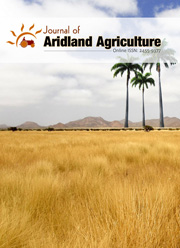EVALUATION OF THE QUALITY STATUS OF AFRICAN NIGHTSHADE SEED PRODUCED BY FARMERS IN KENYA
DOI:
https://doi.org/10.25081/jaa.2019.v5.5488Keywords:
African nightshade, Farm saved seed, germination percentage, seed purityAbstract
Seed as an important input in crop production should be of high quality, pathogen free, have desired germination and emergence. This study was carried out to evaluate the quality status of African nightshade (Solanum scabrum and S. villosum Miller) seed produced by farmers in Kenya. A household survey was carried out in 240 farms using a structured questionnaire and a total of 164 samples of farm saved, market and certified seeds were obtained during this survey. Seed samples were tested in the laboratory at the University of Nairobi and Pearson’s correlation between seed quality and germination parameters was done. The analysis showed that majority of farmers use farm saved (50%) or seed purchased from the local markets (28%) which have low purity and germination rates. The farm, market and certified seed differed (p<0.05) significantly with regard to seed purity, moisture content, seedling vigor index and germination percentage. Farm saved and market seed had low seed purity 68.6% and 74% respectively, compared to certified seed 94.4%. In addition, only certified seed met the recommended moisture and germination percentage as per the International Seed Testing Association (ISTA) standards. There were significant (p≤ 0.05 and p≤0.01) positive correlation comparing seed quality and germination parameters, for example seed purity had significant positive correlation (r=0.76**) with germination percentage. This study affirms that the use of clean seed increases germination percentage of crops.
Downloads
References
2. Ojiewo CO, Mwai GN, Abukutsa-Onyango MO, Agong SG, Nono-Womdim R. Exploiting the genetic diversity of vegetable African nightshades. Bioremediation, Biodiversity and Bioavailability. 2013:7 (1):6-13.
3. Mwai GN, Onyango JC, Abukutsa-Onyango MO. Taxonomic identification and characterization of Africa nightshade (Solanum L. section Solanum). Journal of food, Agriculture, nutrition and development, Maseno University, Kenya.2007:7 (4).
4. Abukutsa-Onyango MO. The diversity of cultivated African leafy vegetables in three communities of Western Kenya. African Journal of food Agriculture nutrition and development.2007: 7(3).
5. Onim M, Mwaniki P. Cataloguing and evaluation of available community/farmers-based seed enterprises on African indigenous vegetables (AIVs) four ECA countries. Lagrotech consultants; 2008.
6. ISTA. International Rules for Seed Testing. Seed Sci. Technol.2014:24: 39-42.
7. FAO/UNESCO. Revised legend for the soil map of Kenya. World soil resources report 68. Rome; 2000.
8. Jaetzold R, Schmidt H, Hornet B, Shisanya C. Farm Management Handbook of Kenya. Ministry of Agriculture, Kenya and German Agency Technical Cooperation team (CTZ). Vol II/C1;2006
9. Taylor, J. The international rules seed testing: 2014 edition ISTA ordinary general meeting; Antalya Turkey; 2014.
10. Dezfuli PM, Sharif-Zadeh F, Janmohammadi M. Influence of priming techniques on seed germination behavior of maize inbred lines (Zea mays L). ARPN Journal of Agricultural and biological science. 2008:3:22-25.
11. Ogunlela YI, Mukhtar AA. Gender issues in agriculture and rural development in Nigeria: The role of women. Humanities and Social Sciences Journal.2009:4:19-30.
12. FAO. The state of food and Agriculture: Food systems for better nutrition. United Nations, Rome, Italy. Food and Agriculture Organization of the United Nations Rome, plant production and protection paper 202; 2013.
13. Manoko MLK. A Systematic Study of African Solanum L. Section Solanum (Solanaceae) (Doctoral dissertation, Ph.D. thesis: Radboud Univesity Nijmegen); 2007.
14. Matasyoh LG, Nyang’au AB. The Solanum nigrum complex (Black nightshade) grown in the Rift valley, Western and Nyanza provinces of Kenya. Journal of life sciences 2016:10:228-232.
15. Olet EA, Manfred H, Kare A. “African Crop or Poisonous Nightshade; the Enigma of Poisonous or Edible Black Nightshade Solved.” African Journal of Ecology. 2005:43:158-61.
16. Nyarango RM, Aloo PA, Kabiru EW, Nyanchongi BO. “The Risk of Pathogenic Intestinal Parasite Infections in Kisii Municipality, Kenya.” BMC Public Health 2008: 8 (1): 237.doi:10.1186/1471-2458-8-237
17. Babiker AZ, Dulloo ME, Mustafa MA, Balla E, Ibrahim ET. Effects of low cost drying methods on seed quality of Sorghum bicolor (L.) Monech. African Journal of Plant Science.2010:4(9):339-345.
18. Osborn T, Napolitano G, Fajardo J. Seeds in Emergencies: A technical handbook. Phaseoli in common bean (Phaseolus vulgaris L.) seeds. Journal of Sustainable Development in Africa.2010:10(1): 105-119.
19. IFPRI. Global food policy report. International food policy research institute Washington DC 114; 2012.
20. Muthii TK. Quality status of farm saved bean Seed in Maragua and management of seed borne diseases by seed treatment. MSc Thesis. University of Nairobi, Kenya;2014
21. Stefano J, Musya DG. Responses of Maize (Zea mays) seed germination capacity and vigour to seed selection based on size of Cob and selective threshing. World Journal of Agricultural Sciences, 2010:6 (6):683-688.
22. Meseret DR, Ali M, Bantte K. 2012. Evaluation of Tomato (Lycopersicon esculentum Mill.) Genotypes for Yield and Yield Components. The African Journal of Plant Science and Biotechnology 2012:6 (1): 45-49.




 .
.